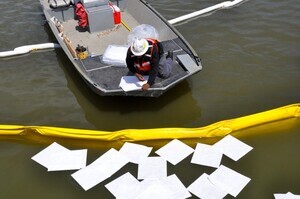Marine Spill Response Procedures: What to Do, What to Use, and How to Be Ready
May 13th 2025

Marine spills don’t offer second chances. Whether it's a small diesel discharge at a private marina or a significant oil release from a commercial vessel, what happens in the first hour often dictates the environmental, legal, and financial impact. That's why effective spill response isn't just about knowing the right steps — it's about having the right tools and being ready to act.
At West Coast Spill Supplies, we've spent decades supporting marine operators, harbours, contractors, and municipalities with spill response products across British Columbia and Washington — and increasingly across North America. In this guide, we’ll walk through the key phases of marine spill response and highlight the equipment that makes each phase work in practice.
The 3 Phases of Marine Spill Response
There are eight recognized steps in marine spill response, but they fall into three logical phases: Detection and Containment, Cleanup and Disposal, and Monitoring and Recovery. Here’s what each involves — and what you’ll need to do it right.
Phase 1: Detection, Notification, and Containment
1. Spill Detection & Initial Notification
Fast detection is your first defence. Spills may be reported by crew, spotted during inspections, or flagged by sensors. Once identified, immediately notify appropriate authorities — such as the Canadian Coast Guard, U.S. Coast Guard, local port or harbour authorities, and any impacted parties.
Tip: Keep emergency contact numbers posted and included in your spill response plan.
2. Safety First
Before jumping in with equipment, make sure your team is protected. Identify hazards (such as flammable vapours or chemical exposure),establish a safety perimeter, and ensure responders are equipped with proper PPE.
3. Containment
This is where response becomes physical — and where equipment matters most.
Containment booms are your primary tool to prevent a spill from spreading. They create a floating barrier around the affected area.
➤ See our containment boom lineupAbsorbent booms serve dual duty — they float and soak up fuel, oil, and other hydrocarbons.
➤ View absorbent booms and socks
Choosing the right boom matters. Read our article on containment vs. absorbent booms
Phase 2: Recovery, Removal, and Waste Handling
4. Spill Recovery
Once contained, cleanup begins.
- For larger spills: Skimmers or vacuum systems may be needed.
- For small-to-moderate spills: Absorbent pads, socks, and pillows are the frontline tools.
➤ Browse marine-rated absorbents
Don’t underestimate how much absorbent you’ll need. Having a mobile marine spill kit on hand ensures everything is ready when time is tight.
➤ View mobile dock spill kits
5. Waste Collection and Disposal
Once oil or fuel is absorbed, you're dealing with contaminated waste, which must be safely bagged, labelled, and disposed of according to local and federal regulations. Your response kit should include:
- Disposal bags
- Labels or tags
- Sealable containers (such as poly drums)
➤ See drum kits for marine spills
Phase 3: Environmental Monitoring and Post-Spill Actions
6. Environmental Assessment
Depending on the severity, you may need to:
- Monitor water quality
- Track wildlife impacts
- Conduct shoreline inspections
Even in smaller incidents, having a process for visual monitoring and water sampling is a smart addition to your response plan.
7. Reporting and Lessons Learned
After the immediate response:
- Document the spill: time, type, estimated volume, response actions, and materials used
- Submit required reports to regulatory bodies
- Review internal processes to improve future readiness
8. Restock and Restore Readiness
One of the most overlooked steps: replacing what you used. Replenish your kits, check boom integrity, inspect PPE, and update your inventory list.
At West Coast Spill Supplies, we can help you refill individual items or rebuild entire kits, ensuring you're ready for the next event — whether you're on Vancouver Island, the Washington coast, or shipping east to clients in Ontario or the Maritimes.
What to Have On Hand: Core Marine Spill Supplies
Every marina, harbour, and vessel operator should have access to the following:
| Equipment | Purpose |
|---|---|
| Containment booms | Prevent spread of spills |
| Absorbent booms | Soak up floating hydrocarbons |
| Pads and rolls | Surface cleanup on water or dock |
| PPE | Keep responders protected |
| Disposal bags and drums | Safe storage of contaminated waste |
| Response plan and contact sheet | Coordination and compliance |
For many clients, the best solution is a ready-to-deploy spill response kit that includes all essentials in one place. If you’re not sure what size or type you need, we’ll help you build a custom kit based on your operations.
Final Thoughts: Be Ready Before You Need to Be
Marine spill response is all about readiness. The procedures are clear — but without the right gear, even the best plans fall short.
Whether you’re operating a coastal fuel dock, maintaining a ferry terminal, or managing a fleet of vessels, West Coast Spill Supplies is here to help you stay prepared. We specialize in practical, proven marine spill solutions — built for real-world conditions on the West Coast and beyond.
Need Help Choosing the Right Marine Spill Kit?
We’ll help you build one that fits your operation.
Contact us today or browse our marine spill kits.
